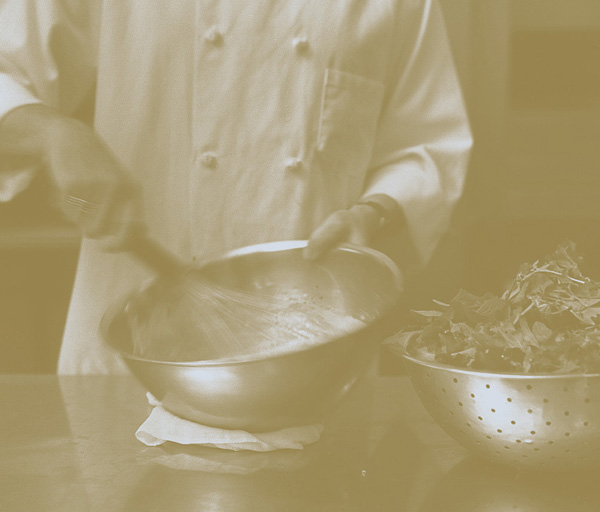
We almost always have a salad at home or as part of our staff meal at Chanterelle. More often than not it’s mixed greens tossed with Ultra Mustardy Vinaigrette (page 350) or David’s Salad Dressing (page 349), my slightly sweet interpretation of a vinaigrette made with honey, soy sauce, and balsamic vinegar. For a change of pace we might prepare a big, crisp Caesar salad loaded with crunchy croutons, and we’re certainly not above the occasional use of salad greens as an excuse to indulge in a sumptuously creamy Green Goddess (page 352) or Blue Cheese Dressing (page 357).
Many of these quick, easy-to-make dressings can also become dips or sauces for crudités, chicken wings, fried seafood, and roasted meats. The similarly versatile and tasty dipping sauces and silken mayonnaises can be slathered on sandwiches, tossed with chicken salad, or used as a soup garnish. The appeal and usefulness of these dressings and sauces is their straightforward flavors. After all, whoever craves a raspberry–poppy seed–pineapple–thyme vinaigrette anyway? Simple nearly always tastes best.
When choosing a salad and its dressing, take into account the other dishes being served at the meal. A creamy main dish is best complemented by one with a vinaigrette rather than a creamy mayonnaise dressing. A delicate main course calls for a lighter-dressed salad as well. As a general rule, creamy dressings and dips offer a pleasing contrast to sauces and other foods that are assertive, such as barbecue and tomato sauces and fried or spicy-hot foods.
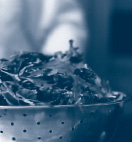
This is my salad dressing standby for family and staff meals. Everyone loves its forthright sweetness with hints of balsamic vinegar, soy sauce, and mustard for balance. It’s a combination that perfectly complements the bitter greens in the mesclun we use at the restaurant. At home I find that it’s wonderful drizzled over composed salads (see box, page 351) made with chicken, beef, or pork, cooked green beans, artichoke hearts, and tomatoes. And a little drizzled over boiled or roast beets adds a finishing touch. The dressing will keep for up to 3 days stored in a tightly covered jar in the refrigerator. MAKES ABOUT 1½ CUPS
1 very fresh large egg (see box, page 359)
1 tablespoon Dijon mustard
1½ tablespoons honey
2½ tablespoons balsamic vinegar, or more to taste
1½ tablespoons good-quality soy sauce, such as Kikkoman
½ cup olive oil
½ cup canola or other vegetable oil
Coarse (kosher) salt (optional)
1. Place the egg, mustard, honey, 2½ tablespoons vinegar, and the soy sauce in a food processor or blender and process until blended and smooth, about 15 seconds.
2. With the machine running, slowly add the oils through the feed tube in a thin, steady stream. The dressing will emulsify nicely to a thick, smooth consistency. Taste and season with salt, if necessary, and additional vinegar, if desired. Store in an airtight container in the refrigerator for up to 3 days.
When it comes to coating salad greens evenly and tastily, you can’t beat a good basic vinaigrette. My family and staff agree that this one does the job with lots of finesse and flavor supplied by an ample amount of Dijon mustard. The assertive mustard calls for a less forceful oil; you’ll find that the combination of extra-virgin olive oil with the neutral canola provides just the right balance. The finished dressing is as creamy looking as homemade mayonnaise, but not nearly as thick, and is lovely drizzled over salad greens, cold meats, or cooked green beans. This vinaigrette is particularly good for composed salads (see box) and makes an excellent crudité dip. Toss some of the dressing with still-hot boiled potatoes and a tablespoon or two of white wine and you’ve got French-style potato salad. MAKES ABOUT 1 CUP
3 tablespoons Dijon mustard
3 tablespoons red wine vinegar
½ cup extra-virgin olive oil
½ cup canola or other vegetable oil
Coarse (kosher) salt and freshly ground black pepper (optional)
1. Place the mustard and vinegar in a food processor or blender and process until blended and smooth, about 15 seconds.
2. With the machine running, slowly add the oils through the feed tube in a thin, steady stream. The vinaigrette will emulsify nicely to a thick, smooth consistency. Taste and season with salt and pepper, if desired. Store in an airtight container in the refrigerator for up to 1 week. Before using, bring to room temperature and whisk briskly to reblend the ingredients.
composed salads
There are basically two types of salads: those consisting primarily of greens (classically known as salade verte), and more substantial ones, such as chef’s salad or salade Niçoise, that feature a variety of other ingredients with greens playing a minor role (classically known as salade composée). The first type, originally served as a salad course meant to cleanse the palate, is a refreshing, understated plate of lightly dressed greens. Diners still enjoy its simplicity and straightforwardness, though it can turn up at any point in the meal and is most often served before the entrée or casually set out on the table in a big bowl.
Composed salads, on the other hand, are a culinary production number, a livelier, more intricate and exciting combination of ingredients with abundantly varied flavors, colors, and textures—foie gras, smoked trout, grilled chicken, duck, tropical fruits, goat cheese. In such salads, greens are secondary. Among the dips and dressings in this chapter that work well with these salads are Green Goddess Dressing (page 352), Ultra Mustardy Vinaigrette (page 350), and Honey Mustard Dip (page 371). Composed salads may be served at any time—scaled down as a first course, scaled up for a lunch or supper main course.
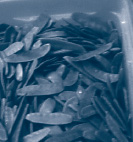
For a change of pace from our usual vinaigrette, we often plug in the food processor and whip up a supply of this classic American dressing with a romantic name and an appealing vivid green color. It tastes as green as it looks—abundantly herbaceous with plenty of zing. Besides salad, you can serve this dressing alongside fish and shellfish or as a sprightly dip with endive leaves and cherry tomatoes. MAKES ABOUT 1½ CUPS
1 bunch fresh flat-leaf parsley
3 very fresh large egg yolks (see page 359)
3 anchovy fillets, drained
Juice of 1 lemon
1 large clove garlic, peeled and roughly chopped
½ teaspoon Dijon mustard
½ cup extra-virgin olive oil
½ cup canola or other vegetable oil
1 teaspoon chopped fresh tarragon leaves
Coarse (kosher) salt and freshly ground black pepper, to taste
Water or milk (optional)
1. Trim the thicker stems from the parsley. Rinse the parsley and shake the water from the leaves, leaving them still a bit damp. Place the leaves in a food processor and process until they’re minced. Scrape the parsley from the processor bowl into the center of a square of dampened cheesecloth. Bring the sides of the cheesecloth up around the parsley and twist to squeeze out as much parsley juice as possible into a bowl. The amount doesn’t matter as long as you get some. Reserve both the juice and the minced parsley.
2. Place the egg yolks, anchovies, lemon juice, garlic, and mustard in a food processor. Process until the mixture is frothy and lightens in color, about 1 minute.
3. With the machine running, slowly add the oils through the feed tube in a thin, steady stream until a light mayonnaise is formed, about 1 minute.
4. Add the chopped parsley, parsley juice, and tarragon and pulse a few times to thoroughly incorporate. Taste the dressing and season with salt and pepper. If the dressing seems too thick, thin it with a little water or milk. Store in an airtight container in the refrigerator for up to 3 days. The tarragon may turn a little khaki colored, but the dressing will still taste good.

anchovies and capers
It’s important to let certain condiments just be themselves. As obvious as it may seem, that’s really the whole point of choosing a particular ingredient in the first place and, by extension, it’s what cooking is all about.
When it comes to most ingredients packed in brine or oil, I believe in using them straight from the bottle or tin—no rinsing, no wiping, no monkeying around.
Anchovy fillets, which are used in Green Goddess Dressing (previous page), Caesar Salad Dressing (page 355), and many other recipes, are a good example. They’re assertively flavored, salty, oily. That’s precisely what I like about them. Many cooks automatically blot up the oil before adding them to a dish, but I take advantage of every bit of their characteristic flavor, which means using anchovies straight from the container without draining them. I welcome their more pronounced flavor and its interaction with other ingredients.
The same goes for piquant, salty capers, which are bottled in vinegared brine. I never rinse them because I want that extra bit of salinity that coats them as they’re spooned from the bottle dripping with brine. Old cooking habits die hard, but you owe it to yourself to try cooking with anchovies and capers this way at least once.
dressing a salad
In my experience people consume widely varying quantities of salad. Some dive right in, acting like rabbits released from a 2-week fast, while others approach the leaves with trepidation, as if they were embarking on an icy sea. The reality of how much salad to allow per person rests in the middle. For individual servings, I usually prepare 2-ounce portions (a big handful of greens), and use about 1 ounce (2 tablespoons) of dressing, just enough to provide a light coating. To make salad for a family or a crowd, simply multiply these amounts. For a Caesar salad I use a bit more dressing—about 2 ounces (¼ cup) per serving—since Caesar dressing is thicker and coats greens more densely. (And besides, I love it!)
Place the greens in a bowl, drizzle them with dressing, and toss very gently with two spoons or a pair of tongs. Take care not to crush the leaves or the salad will look bruised and unappetizing.
Toss thoroughly until the dressing lightly coats all the leaves. Serve immediately. A perfectly dressed salad will not leave a puddle in the bottom of the serving bowl.

It seems strange to me that Caesar salad has made such a big comeback in recent years, especially considering how much of its charm and taste have been lost in the course of its newfound popularity. Commercially bottled Caesar dressings have further tarnished its good name and taste. But a properly made version like this one, redolent with anchovies, Worcestershire sauce, and a good sharp Dijon mustard, is addictive.
This strong and garlicky dressing is best tossed with a sturdy, resilient lettuce like romaine and plenty of croutons. Frailer, more tender lettuces simply won’t hold up in its powerful presence. It’s definitely for anchovy lovers. If you don’t care for anchovies, don’t leave them out—just make another dressing. The recipe makes enough to dress two medium-size heads of romaine. MAKES ABOUT 1½ CUPS
3 very fresh large egg yolks (see box, page 359)
1 tablespoon mashed anchovy fillets or anchovy paste
1 teaspoon minced garlic
5 dashes of Worcestershire sauce, or more to taste
1 tablespoon Dijon mustard
¼ cup white wine vinegar
Squeeze of fresh lemon juice, or more to taste
Coarse (kosher) salt and lots of freshly ground black pepper, to taste
½ cup extra-virgin olive oil
½ cup freshly grated Parmesan
1. Place the egg yolks, anchovies, garlic, 5 dashes Worcestershire sauce, the mustard, vinegar, a squeeze of lemon juice, the salt, and pepper in a food processor or blender. Process until the mixture is frothy and the anchovies are fully incorporated, about 1 minute.
2. With the machine running, slowly add the oil through the feed tube in a thin, steady stream until a light mayonnaise is formed, about 30 seconds. Add the Parmesan and pulse a few times to incorporate. Taste and adjust the seasoning, including the Worcestershire and lemon juice, if necessary. Store in an airtight container in the refrigerator for up to 3 days.
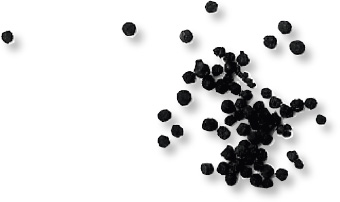
making crisp croutons
Restaurants go through incredible quantities of fresh bread every day. In fact, it would be unforgivable for us to run out of bread, so we always have far more on hand than we need, just in case. None of it goes to waste; day-old bread is routinely transformed into crisps, bread crumbs, and croutons.
To make croutons, trim the crust from day-old bread. I use a good sturdy peasant-style bread, but any kind you have on hand will do. Dice the bread into ½-inch cubes and toss with enough melted butter or olive oil (or, best of all, garlic oil) to coat, but not drench, the croutons. Sprinkle lightly with salt, spread out the croutons on a rimmed baking sheet or a jelly-roll pan, and bake in a preheated 350°F oven until just golden brown, about 15 minutes. Halfway through the baking, give the pan a shake to ensure that the croutons are toasting evenly. The secret of good croutons is to make sure they’ve dried out all the way through without becoming too browned. If they’re browning too quickly, lower the oven temperature to 300°F. When they’re done, remove the pan from the oven.
Cool the croutons completely and store in an airtight container for up to 2 weeks.
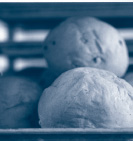
Blue cheese dressing is as useful as it is tasty. Not only is it a flavorful addition to salads, but it’s also the traditional accompaniment to Buffalo chicken wings, a splendid dip for everything from crudités to potato chips, and irresistible slathered on a roast turkey sandwich. I use inexpensive Danish blue cheese to make this dressing. Authentic and expensive French Roquefort is one of the world’s stellar cheeses, but the quality and subtle nuances of a finer blue cheese would just be overwhelmed by the other ingredients. MAKES ABOUT 2 CUPS
4 very fresh large egg yolks (see box, page 359)
1 teaspoon Dijon mustard
¼ teaspoon minced garlic
¼ cup white wine vinegar
Coarse (kosher) salt and freshly ground black pepper, to taste
Dash of Tabasco sauce
1½ cups canola or other vegetable oil
4 ounces blue cheese, crumbled
1. Place the egg yolks, mustard, garlic, vinegar, salt, pepper, and Tabasco in a food processor or blender. Process until the mixture is frothy and turns lighter in color, about 1 minute.
2. With the machine running, slowly add the oil through the feed tube in a thin, steady stream, about 1½ minutes. The dressing will emulsify nicely to a thick, smooth consistency. Add the blue cheese and pulse the machine a few times until it’s fully incorporated. Taste and adjust the seasoning. Store in an airtight container in the refrigerator for up to 3 days.
Creamy Italian Dressing is indeed creamy, but I doubt that this, or anything remotely like it, ever originated in Italy. It’s one of those commercially bottled concoctions that’s been a staple in American kitchen pantries for generations and is still going strong on supermarket shelves. If I had to guess, I’d say it was probably the brainstorm of a product development whiz at a food manufacturing conglomerate. Like the “original,” mine has no real ethnic provenance, but it’s a light, flavorful, herb-flecked dressing that certainly tastes good. Use it on more delicate greens such as oakleaf, red-leaf, or Bibb lettuce. MAKES ABOUT 1 CUP
1 very fresh large egg (see box)
¼ cup white wine vinegar
1 teaspoon Dijon mustard
¼ cup freshly grated Parmesan
1 small clove garlic, peeled and roughly chopped
Coarse (kosher) salt and freshly ground black pepper, to taste
⅓ cup extra-virgin olive oil
1 teaspoon dried oregano leaves
1 teaspoon chopped fresh flat-leaf parsley leaves
1. Place the egg, vinegar, mustard, Parmesan, garlic, salt, and pepper in a food processor or blender. Process until the mixture gets frothy and lighter in color, about 1 minute.
2. With the machine running, slowly add the oil through the feed tube in a thin, steady stream, about 30 seconds. The dressing will emulsify nicely to a smooth consistency. Add the oregano and parsley and pulse a few times to just incorporate. Store in an airtight container in the refrigerator for up to 3 days.
a note about eggs
In the past few years there has been legitimate concern over the use of raw eggs in foods that aren’t cooked. Although statistics suggest that a minuscule number of eggs potentially carry the salmonella bacteria, it’s believed that consuming uncooked eggs may pose a risk to the very young, the elderly, pregnant women, and anyone with a compromised immune system. Acidic ingredients such as vinegar or lemon juice may create a less hospitable environment for bacteria in uncooked egg mixtures such as mayonnaise. When shopping, buy only very fresh, refrigerated eggs with undamaged shells from top-notch purveyors.
At home, keep eggs refrigerated, use a plastic or metal egg separator, and do not allow dishes made with raw eggs to sit out at room temperature. Use eggs within a day or two of purchase if you’ll be using them in a recipe calling for raw eggs.
The flavor of a homemade mayonnaise is in a whole other realm from commercial versions. It tastes so much fresher and more interesting that it’s easily worth spending the few minutes required to make it. Whether you make it in a food processor or whisk it by hand, there’s always something magical about seeing the thick, creamy emulsion form. If 2 cups is too much, this recipe is easy to halve. MAKES ABOUT 2 CUPS
4 very fresh large egg yolks (see page 359)
2 tablespoons fresh lemon juice
2 tablespoons water
2 teaspoons Dijon mustard
1 cup extra-virgin olive oil
1 cup canola or other vegetable oil
Coarse (kosher) salt and freshly ground black pepper, to taste (optional)
1. Place the egg yolks, lemon juice, water, and mustard in a food processor or blender. Process until the mixture is frothy and turns lighter in color, about 1 minute.
2. With the machine running, slowly add the oils through the feed tube in a thin, steady stream, about 2 minutes. The mayonnaise will emulsify nicely to a thick, smooth consistency. Taste and season with salt and pepper, if desired. Store in an airtight container in the refrigerator for up to 3 days.
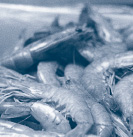
We use this bright yellow mayonnaise as the dressing for our Curried Chicken Salad (page 187), but it’s also perfect with a cold roast pork sandwich or as a dipping sauce for boiled shrimp. I prefer to use Madras-style Sun brand curry powder from the south of India, which is very flavorful yet mellow, not too spicy, with just a subtle hint of extra heat. Look for it in most large supermarkets and specialty food stores. Don’t skip the first step of briefly warming the curry powder in oil. The heat brings the spices to life, eliminating any powdery, uncooked taste. As with Basic Mayonnaise (page 360), this recipe is easy to halve. MAKES ABOUT 2 CUPS
2 cups canola or other vegetable oil
2 tablespoons Madras-style curry powder, preferably Sun brand
4 very fresh large egg yolks (see box, page 359)
3 tablespoons fresh lemon juice
2 teaspoons Dijon mustard
Coarse (kosher) salt (optional)
1. Combine 6 tablespoons of the oil and the curry powder in a small, heavy saucepan and heat over low heat, stirring to release the flavor of the curry powder, 2 minutes. Be careful not to let the mixture get too hot and overcook. Remove the pan from the heat and let cool to room temperature.
2. Combine the egg yolks, lemon juice, and mustard in a food processor or blender. Process until the mixture is frothy and turns lighter in color, about 1 minute.
3. With the machine running, slowly add the remaining oil through the feed tube in a thin, steady stream, about 2 minutes. The mayonnaise will emulsify nicely to a thick, smooth consistency. Add the curry oil and continue to process until it’s thoroughly blended in. Taste and season with salt, if desired. Store in an airtight container in the refrigerator for up to 3 days.
If you rarely use fresh tarragon, the flavor of this mayonnaise will be a revelation. By nature fresh tarragon is delicate, with a subtle and enchanting licorice flavor that’s often eclipsed when it’s dried. Unlike many other herbs that easily retain their integrity of flavor when dried, tarragon tends to lose most of its allure, becoming too intense, yet with a rather lackluster, dusty taste. For this reason, only chopped fresh tarragon will do here. The result is an elegantly flavorful mayonnaise that can be used to create a wonderful Chicken Salad with Tarragon (page 188). It also makes a lovely sauce for cold poached salmon, chilled boiled shrimp, or room-temperature slices of roast chicken. As with the other mayonnaises, halve the recipe if you don’t need quite so much. MAKES ABOUT 2 CUPS
4 very fresh large egg yolks (see box, page 359)
6 tablespoons tarragon vinegar, or more to taste
2 teaspoons fresh tarragon leaves
2 teaspoons Dijon mustard
Coarse (kosher) salt and freshly ground black pepper, to taste
1 cup extra-virgin olive oil
1 cup canola or other vegetable oil
1. Place the egg yolks, 6 tablespoons vinegar, the tarragon, mustard, salt, and pepper in a food processor or blender. Process until the mixture is frothy and turns lighter in color, about 1 minute.
2. With the machine running, slowly add the oils through the feed tube in a thin, steady stream, about 2 minutes. The mayonnaise will emulsify nicely to a thick, smooth consistency. Taste and adjust the vinegar and salt and pepper, if necessary. Store in an airtight container in the refrigerator for up to 3 days.
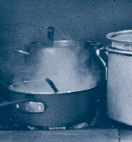
This garlic mayonnaise is our favorite dip. I make my aïoli quite garlicky, but you can adjust the amount to make it less so if you prefer. The texture can also be varied. Mine is thick—just slightly thinner than commercial mayonnaise. That’s how they do it in Provence, where a pungent bowl of aïoli is often served with crudités at the beginning of a meal. For a very snappy-tasting salad dressing, thin the mixture by using less oil or by adding some water. Thick, it makes a perfect garnish for bouillabaisse and other fish stews or soups. Simply add a dollop of aïoli to the soup—on its own or on a crusty toast round—and let it blend in as you eat. MAKES ABOUT 2 CUPS
4 very fresh large egg yolks (see box, page 359)
3 tablespoons white wine vinegar or fresh lemon juice
5 large cloves garlic, peeled
2 teaspoons Dijon mustard
Coarse (kosher) salt and freshly ground black pepper, to taste
1 cup extra-virgin olive oil
1 cup canola or other vegetable oil
1. Place the egg yolks, vinegar, garlic, mustard, salt, and pepper in a food processor or blender. Process until the mixture is frothy, it turns lighter in color, and the garlic is finely chopped, about 1 minute.
2. With the machine running, slowly add the oils through the feed tube in a thin, steady stream, about 2 minutes. The aïoli will emulsify nicely to a thick, smooth consistency. Taste and adjust the seasoning, if necessary. Store in an airtight container in the refrigerator for up to 3 days.
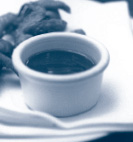
Flat-leaf parsley comes into its own as an herb rather than a garnish in this vivid green sauce with its bright, strong, zingy flavor. To achieve an even brighter green, add some blanched spinach leaves. This is quite anchovy intensive, so if you don’t love them, prepare the sauce with fewer than specified, then take a taste before deciding whether to add the full amount. (To tell the truth, when I make this at home I add even more anchovies!) Use the sauce the day it’s made. (Refrigeration turns the color an unappetizing khaki and breaks down the mayonnaiselike texture.) Let the sauce rest, covered and at room temperature, for at least an hour before serving so the flavors have an opportunity to expand and blend. You won’t find a more compatible sauce for boiled beef, fried fish, or hot or cold poached fish (especially salmon)—or a better dip for vegetables, either raw or lightly cooked. Green sauce is also a classic accompaniment for Pot-au-Feu (page 63). MAKES ABOUT 1½ CUPS
3 to 4 bunches fresh flat-leaf parsley
½ cup loosely packed fresh spinach leaves, rinsed and drained (optional)
3 large eggs
8 anchovy fillets packed in oil, drained
3 tablespoons capers, drained but not rinsed
3 tablespoons red wine vinegar
2 cloves garlic, peeled
1 tablespoon Dijon mustard
1 cup extra-virgin olive oil
Water, as needed
1. Bring a medium-size saucepan filled halfway with water to a boil over medium-high heat.
2. Meanwhile, using a sharp, heavy knife, roughly chop enough parsley, including some thinner stems, to make 4 cups loosely packed. If you wish to give the sauce an extra bright green color, use the spinach, chopping it roughly as well. Add the greens to the boiling water and blanch for a few seconds, just until they wilt and turn bright green. Drain in a colander, cool under cold running water, and drain again. Squeeze out the rest of the water, chop finely, and set aside.
3. Place the eggs in the saucepan, cover with water, and bring to a simmer over medium heat. Reduce the heat to maintain a slow but steady simmer and cook the eggs until just short of hard cooked, about 7 minutes; you want the yolks to be a little soft. Place the saucepan in the sink and run cold water into it until all the hot water is driven out; let the eggs sit in the water until cool.
4. Peel the eggs and carefully separate the yolks from the whites, discarding the whites. Place the yolks in a food processor and add the chopped greens, anchovies, capers, vinegar, garlic, and mustard. Process until the mixture forms a paste that’s as fine as possible, 3 to 5 minutes (see Note).
5. With the machine running, slowly add the oil through the feed tube in a thin, steady stream, about 1 minute. The sauce will emulsify nicely to a thick, smooth consistency. If desired, thin with a little water before using.
Note: Due to the nature of flat-leaf parsley, the mixture in step 4 will be a bit grainy rather than totally smooth.
big dippers
We’re constantly busy at Chanterelle, dashing around the kitchen, always in the middle of something. Our work shifts are long, so when hunger strikes we look around eagerly for tasty little snacks we can gobble on the run. That’s how we became inveterate dippers. Rémoulade, tamarind sauce, aïoli, tomato-porcini sauce, simple vinaigrette—we love them all. During service, when diners are feasting and the kitchen is in high gear, the cooks pour leftover sauces from the various skillets into little dishes and set them out near bits of bread. If they’re really rushed, they’ll just toss a pan onto the counter and holler, “Snack!” Waiters in the nether regions of the dining room appear like magic—how do they know?
Rémoulade is basically French tartar sauce. Its pleasing tartness, created by Dijon mustard, capers, and cornichons, makes it a perfect accompaniment to cold meats, shellfish, and fried or sautéed fish. And Our Favorite Fries (page 327) become unexpectedly elegant when they’re served with little saucers of rémoulade instead of the usual ketchup. This recipe is a fine example of what happens when a few basic ingredients come together in precisely the right combination. MAKES ABOUT 2 CUPS
1 shallot, peeled and cut into large pieces
2 tablespoons small (nonpareil) capers
10 cornichons, cut into large pieces
4 very fresh large egg yolks (see page 359)
¼ cup white wine vinegar
1 teaspoon Dijon mustard
Coarse (kosher) salt and freshly ground black pepper, to taste
2 cups extra-virgin olive oil
Liquid from the capers or cornichons, as needed
1. Place the shallot, capers, and cornichons in a food processor or blender and pulse until they’re coarsely chopped. Use a rubber spatula to scrape the mixture into a bowl and set aside.
2. Without rinsing the processor, add the egg yolks, vinegar, mustard, salt, and pepper. Process until the mixture is frothy and turns lighter in color, about 1 minute.
3. With the machine running, slowly add the oil through the feed tube in a thin, steady stream, about 2 minutes. The sauce will emulsify nicely to a thick, smooth consistency. Add the shallot mixture and pulse a few times just to incorporate. The rémoulade should be chunky. Taste and adjust the seasoning, adding some caper or cornichon liquid to increase the acidity, if necessary. Store in an airtight container in the refrigerator for up to 3 days.
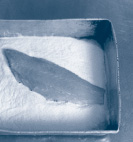
Here’s a fast, uncomplicated, and unfussy tartar sauce that can be made in the blink of an eye. It’s infinitely finer tasting than any commercial version. Serve a bowl of this along with Fresh Salmon Croquettes (page 218), Deviled Crab Cakes (page 245), or Fish ’n’ Chips (page 234). MAKES ABOUT 1 CUP
1 cup good-quality commercial mayonnaise, preferably Hellmann’s
3 tablespoons commercial chopped sweet relish
3 tablespoons bottled white horseradish, measured after thorough draining
½ teaspoon sherry vinegar
Place all the ingredients in a small bowl and whisk thoroughly until well blended. Store in an airtight container in the refrigerator for up to 3 days.
about capers
A classic ingredient in Rémoulade (page 366), capers are the preserved flower buds of two types of trailing shrubs that grow in the Mediterranean. Glass jars of vinegar-cured capers in brine are easy to find at supermarkets and specialty food stores. (Less common salt-cured ones are sold in Italian specialty food shops.) Their nearly indescribable, slightly acidic flavor adds a bright, piquant note to sauces and tapenade (they have a special affinity for anchovies and olives). Capers come in a range of sizes. I always use the smallest, labeled “nonpareil,” because they have a bit more flavor than larger ones. Although many cooks drain the brine and rinse capers so they’re less salty, I never bother. I love the impact of their brininess and salt, especially in sauces.
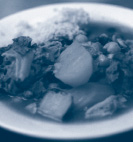
Harissa is a fiery hot red chili paste with roots in North Africa. It’s a bold-tasting, russet-colored mixture of hot chiles ground to a paste with garlic, olive oil, paprika, coriander, cumin, and caraway seeds. Harissa is most often associated with couscous, the traditional dish of steamed semolina served with a vegetable or meat stew. A dab is often added to the stew broth for extra flavor before serving, and harissa also appears as a condiment on the table so diners can further adjust the heat to suit their palates. Excellent ready-made harissa from France is sold in colorful little yellow tins or convenient squeeze tubes in Middle Eastern markets, specialty food stores, and some large supermarkets. Strange as it may sound, I’ve found that doctoring this wonderful condiment creates an even fresher, more integrated flavor, rounding the edges of its stark heat just a bit. Stir my new and improved version sparingly (it’s still very hot!) into scrambled eggs, rice and beans, vinaigrette, homemade mayonnaise for potato salad, marinades, or soups and stews. And black olives tossed with a little harissa are simply wonderful. To store, spoon into a small glass jar, pour a thin layer of olive oil on the surface, cap tightly, and refrigerate. MAKES ABOUT ¾ CUP
1 can (4.785 ounces) harissa
2 tablespoons extra-virgin olive oil
1 teaspoon tomato paste
2 tablespoons finely chopped fresh cilantro leaves (see Note)
Juice of 1 lemon
Combine the harissa, oil, tomato paste, and cilantro in a small bowl and whisk until well blended. Add the lemon juice and stir. Transfer to a pretty serving bowl and serve. Store in an airtight container in the refrigerator for up to 3 months.
Note: Adding fresh cilantro to the harissa will shorten its shelf life considerably, since fresh herbs tend to lose their color, texture, and potency quickly. In fact, with the herb mixed in, it’s best to eat up the harissa within a couple of days. That very well may be out of the question, however, just a little of this stuff packs a wallop. So it’s probably best to mix all the ingredients—except the cilantro—together. Then scoop out just the portion of paste you’ll be serving and add a reduced amount of cilantro to it. For instance, if you think ¼ cup will meet your needs, add a couple of teaspoons of chopped cilantro and store the rest of the harissa cilantro-free until the next time you serve it. Don’t worry about getting the amount of cilantro exactly right. Being a little off one way or the other won’t matter.
This sharp, piquant sauce is perfect to serve alongside roast beef, pork, or turkey. It also makes an exceptionally tasty dip for raw vegetables. You can use either commercially bottled horseradish or much stronger fresh homemade horseradish, which is what I prefer. MAKES ABOUT 2 CUPS
4 very fresh large egg yolks (see page 359)
⅓ cup white wine vinegar, or more to taste
½ teaspoon Dijon mustard
Coarse (kosher) salt and freshly ground black pepper, to taste
1½ to 2 cups extra-virgin olive oil
¼ cup freshly ground horseradish (see box, page 370) or ½ cup drained, bottled horseradish, or more to taste
1. Place the egg yolks, ⅓ cup vinegar, the mustard, salt, and pepper in a food processor or blender. Process until the mixture is frothy and turns a lighter color, about 1 minute.
2. With the machine running, slowly add the oil through the feed tube in a thin, steady stream, stopping when the desired consistency is achieved, 1½ to 2 minutes. I like a loose, pourable horseradish sauce (about 1½ cups oil) rather than a thick one. Add the horseradish and pulse a few more times to thoroughly incorporate. Taste, adding more horseradish if desired, and perhaps a touch more vinegar or salt. Serve cold. Store in an airtight container in the refrigerator for up to 3 days.
fresh homemade horseradish
Large, tapered roots of fresh horseradish, which average 8 to 12 inches in length, are usually available in produce departments year-round, although they’re at their best from fall through spring. Choose those that are firm, smooth, and unblemished. One root can yield anywhere from ¾ cup to 1 cup of grated horseradish.
To prepare a small amount of homemade horseradish, peel only part of the root, about 2 or 3 inches. (Wrap the unpeeled portion in plastic wrap; it will stay fresh in the refrigerator for up to 2 weeks before the flavor begins to fade.) Cut the peeled portion into ½-inch pieces and grind in a food processor, pulsing in short bursts until finely chopped or shredded but not puréed. If it seems dry, add a few drops of water or white vinegar. The fumes from freshly ground horseradish are powerfully peppery and potent, so avert your head as you remove the food processor top. To store leftover ground horse-radish, put it in an airtight glass container with just enough white vinegar to cover and refrigerate. It will keep for up to 2 months. One tablespoon of fresh homemade horseradish is equivalent to 2 tablespoons of the bottled kind.
Aside from its use as an ingredient in Horseradish Sauce (page 369), a little of the ground root will add interesting zip to applesauce, cranberry sauce or compote, plain mayonnaise, and, of course, a Bloody Mary.
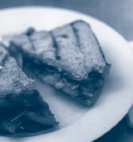
Quick and easy is an understatement here, since it will take you about as long to read this recipe as to make it. The sharp, full-flavored heat of Dijon mustard (I use Maille brand, which is strong) and the straightforward sweetness of honey are combined with just enough soy sauce and cider vinegar to give this versatile sauce a little kick. There’s no need to rush out and buy some fancy imported, highly flavored honey that makes a statement. Supermarket honey is what you want here. This is terrific served with David’s Famous Fried Chicken (page 157), fried fish fillets, or hot grilled bratwurst; as a dip for pretzels or Chicken McWaltucks (page 180); or thinly spread on a ham sandwich. Some people even put it on salad, though I think it’s a bit too strong for most greens. Or you could enjoy it the way I do, by just dipping a finger in it. MAKES ABOUT 1½ CUPS
1 cup plus 2 tablespoons Dijon mustard
½ cup honey
2 tablespoons good-quality soy sauce, preferably Kikkoman
2 tablespoons cider vinegar
Combine all the ingredients in a food processor or blender and process until blended. Store the dip in an airtight container in the refrigerator. It will keep almost indefinitely.
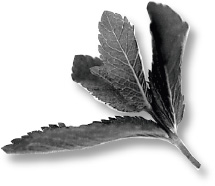

Tamarind water gives this very nicely balanced, tart-yet-sweet dipping sauce its lovely deep orange color and unusual flavor. The sauce is delicious with Vidalia Onion Fritters (page 326) and other fried foods. MAKES ABOUT 2 CUPS
5 ounces tamarind pulp (see box)
2 cups plus 2 tablespoons cold water
1 piece (1 inch) fresh ginger, peeled and grated
3 cloves garlic, minced
3 tablespoons sugar, or more to taste
1 tablespoon chili-garlic sauce (sambal oelek)
2 teaspoons Thai fish sauce (nam pla)
1 teaspoon good-quality soy sauce, such as Kikkoman
2 tablespoons cornstarch
1. Combine the tamarind and 2 cups of the water in a small saucepan and bring to a boil over high heat. Remove the pan from the heat and let stand until the tamarind has softened, about 15 minutes. Help it along by breaking up the pulp with a spoon.
2. Strain the tamarind through a sieve, pressing on the pulp to extract as much water as possible. Discard the pulp and seeds and return the water to the pan. Add the ginger, garlic, 3 tablespoons sugar, the chili-garlic sauce, fish sauce, and soy sauce and bring to a boil over high heat. Reduce the heat and simmer for 5 minutes, stirring frequently.
3. Whisk the cornstarch with the remaining 2 tablespoons water. When smooth, whisk the mixture into the tamarind sauce, continuing to whisk until the sauce thickens, about 1 minute. Remove the pan from the heat and let cool. Before serving, taste and adjust the seasoning, adding more sugar if necessary to balance the tartness of the tamarind. Store tamarind sauce in an airtight container in the refrigerator for up to 1 week.
tamarind pulp
Tamarind pulp comes from the fuzzy, beanlike pods of the tamarind tree. It’s used extensively in Southeast Asian cooking to add a rich, slightly sweet-sour taste to dressings, sauces, and soups. Commercially, tamarind is one of the “secret” ingredients in Worcestershire sauce. The unseeded pulp is sold in plastic-wrapped 16-ounce blocks in Asian markets and some specialty food stores. To extract the tart tamarind essence, about 1 part pulp is combined with 3 parts boiling water, and the mixture is allowed to rest briefly. The softened pulp is then strained through a sieve to extract the juice and remove any seeds and fibers before the resulting liquid is used. (A little pulp invariably ends up in the liquid, which is okay.) The seedless tamarind concentrate sold at Middle Eastern, Asian, and Caribbean markets is easier to use, but the flavor won’t be quite as good as that of the blocks of Asian pulp.